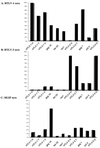Human T-cell lymphotropic virus type 1 gag indeterminate western blot patterns in Central Africa: relationship to Plasmodium falciparum infection
- PMID: 11060067
- PMCID: PMC87540
- DOI: 10.1128/JCM.38.11.4049-4057.2000
Human T-cell lymphotropic virus type 1 gag indeterminate western blot patterns in Central Africa: relationship to Plasmodium falciparum infection
Abstract
To gain insight on the significance of human T-cell lymphotropic virus type 1 (HTLV-1) indeterminate serological reactivities, we studied villagers of South Cameroon, focusing on a frequent and specific HTLV-1 Gag indeterminate profile (HGIP) pattern (gag p19, p26, p28, and p30 without p24 or Env gp21 and gp46). Among the 102 sera studied, 29 from all age groups had a stable HGIP pattern over a period of 4 years. There was no epidemiological evidence for sexual or vertical transmission of HGIP. Seventy-five percent of HGIP sera reacted positively on MT2 HTLV-1-infected cells by immunofluorescence assay. However, we could not isolate any HTLV-1 virus or detect the presence of p19 Gag protein in cultures of peripheral blood mononuclear cells obtained from individuals with strong HGIP reactivity. PCR experiments conducted with primers for HTLV-1 and HTLV-2 (HTLV-1/2 primers) encompassing different regions of the virus did not yield HTLV-1/2 proviral sequences from individuals with HGIP. Using 11 peptides corresponding to HTLV-1 or HTLV-2 immunodominant B epitopes in an enzyme-linked immunosorbent assay, one epitope corresponding to the Gag p19 carboxyl terminus was identified in 75% of HGIP sera, while it was recognized by only 41% of confirmed HTLV-1-positive sera. A positive correlation between HTLV-1 optical density values and titers of antibody to Plasmodium falciparum was also demonstrated. Finally, passage of sera through a P. falciparum-infected erythrocyte-coupled column was shown to specifically abrogate HGIP reactivity but not the HTLV-1 pattern, suggesting the existence of cross-reactivity between HTLV-1 Gag proteins and malaria-derived antigens. These data suggest that in Central Africa, this frequent and specific Western blot is not caused by HTLV-1 infection but could instead be associated with P. falciparum infection.
Figures




Similar articles
-
Serological, epidemiological, and molecular differences between human T-cell lymphotropic virus Type 1 (HTLV-1)-seropositive healthy carriers and persons with HTLV-I Gag indeterminate Western blot patterns from the Caribbean.J Clin Microbiol. 2001 Apr;39(4):1247-53. doi: 10.1128/JCM.39.4.1247-1253.2001. J Clin Microbiol. 2001. PMID: 11283036 Free PMC article.
-
Demographic, ethnic, and geographic differences between human T cell lymphotropic virus (HTLV) type I-seropositive carriers and persons with HTLV-I Gag-indeterminate Western blots in Central Africa.J Infect Dis. 1997 Aug;176(2):505-9. doi: 10.1086/514071. J Infect Dis. 1997. PMID: 9237719
-
Human T lymphotropic virus types I and II proviral sequences in Argentinian blood donors with indeterminate Western blot patterns.J Med Virol. 2004 Oct;74(2):323-7. doi: 10.1002/jmv.20172. J Med Virol. 2004. PMID: 15332282
-
The prevalence and significance of HTLV-I/II seroindeterminate Western blot patterns.Viruses. 2011 Aug;3(8):1320-31. doi: 10.3390/v3081320. Epub 2011 Aug 2. Viruses. 2011. PMID: 21994781 Free PMC article. Review.
-
Delineation of immunodominant epitopes of human T-lymphotropic virus types I and II and their usefulness in developing serologic assays for detection of antibodies to HTLV-I and HTLV-II.J Acquir Immune Defic Syndr Hum Retrovirol. 1996;13 Suppl 1:S170-8. doi: 10.1097/00042560-199600001-00026. J Acquir Immune Defic Syndr Hum Retrovirol. 1996. PMID: 8797720 Review.
Cited by
-
Geographic distribution, clinical epidemiology and genetic diversity of the human oncogenic retrovirus HTLV-1 in Africa, the world's largest endemic area.Front Immunol. 2023 Feb 3;14:1043600. doi: 10.3389/fimmu.2023.1043600. eCollection 2023. Front Immunol. 2023. PMID: 36817417 Free PMC article. Review.
-
Emergence of unique primate T-lymphotropic viruses among central African bushmeat hunters.Proc Natl Acad Sci U S A. 2005 May 31;102(22):7994-9. doi: 10.1073/pnas.0501734102. Epub 2005 May 23. Proc Natl Acad Sci U S A. 2005. PMID: 15911757 Free PMC article.
-
Bioprospection and Selection of Peptides by Phage Display as Novel Epitope-Based Diagnostic Probes for Serological Detection of HTLV-1 and Use in Future Vaccines.Front Med (Lausanne). 2022 Jun 9;9:884738. doi: 10.3389/fmed.2022.884738. eCollection 2022. Front Med (Lausanne). 2022. PMID: 35755076 Free PMC article.
-
Untangling the causes of geographical disparities in the clinical outcome of HTLV-1 infection: a critical perspective on the contribution of viral genetic diversity.J Virol. 2025 Aug 19;99(8):e0060125. doi: 10.1128/jvi.00601-25. Epub 2025 Jul 7. J Virol. 2025. PMID: 40622170 Free PMC article. Review.
-
A Strategy for Screening and Confirmation of HTLV-1/2 Infections in Low-Endemic Areas.Front Microbiol. 2020 Jun 3;11:1151. doi: 10.3389/fmicb.2020.01151. eCollection 2020. Front Microbiol. 2020. PMID: 32582093 Free PMC article.
References
-
- Anonymous. Acquired immunodeficiency syndrome (AIDS). Proposed WHO criteria for interpreting results from western blot assays for HIV-1, HIV-2, and HTLV-I/HTLV-II. Wkly Epidemiol Rec. 1990;65:281–283. - PubMed
-
- Anonymous. Seroepidemiology of the human T-cell leukaemia/lymphoma viruses in Europe. The HTLV European Research Network. J Acquir Immune Defic Syndr Hum Retrovirol. 1996;13:68–77. - PubMed
-
- Asher D M, Goudsmit J, Pomeroy K L, Garruto R M, Bakker M, Ono S G, Elliot N, Harris K, Askins H, Eldadah Z, et al. Antibodies to HTLV-I in populations of the southwestern Pacific. J Med Virol. 1988;26:339–351. - PubMed
-
- Banki K, Maceda J, Hurley E, Ablonczy E, Mattson D H, Szegedy L, Hung C, Perl A. Human T-cell lymphotropic virus (HTLV)-related endogenous sequence, HRES-1, encodes a 28-kDa protein: a possible autoantigen for HTLV-I gag-reactive autoantibodies. Proc Natl Acad Sci USA. 1992;89:1939–1943. - PMC - PubMed
-
- Biggar R J, Gigase P L, Melbye M, Kestens L, Sarin P S, Bodner A J, Demedts P, Stevens W J, Paluku L, Delacollette C, et al. ELISA HTLV retrovirus antibody reactivity associated with malaria and immune complexes in healthy Africans. Lancet. 1985;2:520–523. - PubMed
Publication types
MeSH terms
Substances
LinkOut - more resources
Full Text Sources
Other Literature Sources
Medical

